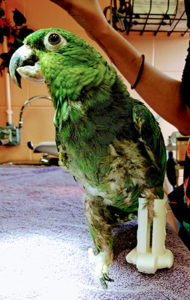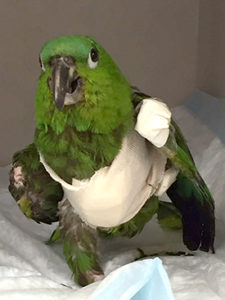 We’ve seen many amazing stories of 3D printing technology helping injured birds, from 3D printed beaks and feet to orthotic boots, leg braces, and prosthetic legs. A 34-year-old Mealy Amazon parrot named Pete was the recipient of his own 3D printed prosthetic after he survived an unfortunate injury. Pete’s story is remarkable, and not just because 3D printing swooped in to save the day again – the saga of Pete’s prosthetic serves as a functional example of the teamwork and trial and error process involved with 3D printing a custom device.
We’ve seen many amazing stories of 3D printing technology helping injured birds, from 3D printed beaks and feet to orthotic boots, leg braces, and prosthetic legs. A 34-year-old Mealy Amazon parrot named Pete was the recipient of his own 3D printed prosthetic after he survived an unfortunate injury. Pete’s story is remarkable, and not just because 3D printing swooped in to save the day again – the saga of Pete’s prosthetic serves as a functional example of the teamwork and trial and error process involved with 3D printing a custom device.
Benjamin Spalding heard Pete screaming in his backyard aviary, and got there just in time to see a fox rip Pete’s foot off. Pete was loaded into his carrying cage, and after Spalding’s wife made a few phone calls to find an emergency animal hospital with an experienced exotic animal vet, they were off to Ryan Veterinary Hospital, which is part of the University of Pennsylvania School of Veterinary Medicine (Penn Vet) community,
After Pete was medicated and sedated, the emergency team saw that his left leg had been severed midway below his knee, and that he also had a small chest wound. A supportive bandage kept his leg comfortable overnight, and even though Pete had lost a lot of blood, the team knew he would likely survive, as birds can reproduce red blood cells much more quickly than humans can. A bird would have to lose 60% of its total volume of blood before showing any significant changes in blood pressure.
The next day, Pete had a round of antibiotics, a blood test, and a CT scan, so that his doctor could “characterize what was going on underneath the skin.”
“With this imaging, we were able to see the full nature of Pete’s injury, which really helped with surgical planning. We got Pete into surgery within 48 hours,” said Dr. La’Toya Latney, the Service Head and Attending Clinician of Penn Vet’s Exotic Companion Animal Medicine service.
After the surgeons removed some of the damaged tissue that had been infected from the fox bite, they were relieved to see that Pete’s femur and hip bones were intact, so they were able to save the bit of leg below his knee. Dr. Latney said Pete was affectionate and seemed to be much more comfortable post-op, but his journey wasn’t over. Most birds are able to handle just one leg, but only if they weigh less than 100 grams; since Pete is larger-bodied, he was looking at painful, long-term arthritis.
In order to get Pete the support he would need, Dr. Latney contacted Dr. Jonathan Wood, Staff Veterinarian in Penn Vet’s Neurology and Neurosurgery department; Dr. Wood has previously used 3D printed models in surgical teaching and planning.
Dr. Wood said, “I wanted to see what we could do for Pete with 3D printing. We think about animals that will rehab well and animals that will rehab poorly, similar to people. If there was a parrot that wanted to use what we made for him, Pete seemed to be a good candidate.”
 Dr. Wood and Stephen Smeltzer, the Digital Fabrication Manager at PennDesign’s Fabrication Lab, studied Pete’s CT scan, and started to discuss what kind of prosthetic to make, factoring in how much the prosthetic should weigh, how stiff it would need to be, and how it could be attached. Pete was sent home to allow his stump time to heal and shrink, and his team got to work developing the first 3D printed prototypes.
Dr. Wood and Stephen Smeltzer, the Digital Fabrication Manager at PennDesign’s Fabrication Lab, studied Pete’s CT scan, and started to discuss what kind of prosthetic to make, factoring in how much the prosthetic should weigh, how stiff it would need to be, and how it could be attached. Pete was sent home to allow his stump time to heal and shrink, and his team got to work developing the first 3D printed prototypes.
While they looked a lot like Pete’s actual foot, they proved too fragile and thin to offer any support. Dr. Wood asked fourth-year student Gregory Kaiman to help out, and Kaiman, who’s interested in the potential benefits that 3D printing technology can provide to veterinary medicine, got in touch with the university’s Biomedical Library 3D printing group. This led him to design a custom model, instead of trying to make one using Pete’s CT scan.
Kaiman explained, “Dr. Wood was kind enough to share some pictures of Pete’s stump with measurements, and I began experimenting. After much trial and error, I got a little faster and a little better.”
The two made some major changes to the prosthetic leg design, but the big game-changer came when Kaiman found out that the Biomedical Library’s 3D printers, which include a Formlabs Form 2, a MakerBot Replicator 2, and a Stratasys uPrint SE Plus, can 3D print using different materials, textures, and weights. The new 3D printed prosthetic leg prototypes, made from extruded polymer resin, looked more like a walking boot and less like a foot, which meant that while they were bulkier, they were more stable. Pete allowed Dr. Latney to attach the prosthetic to his leg, and he was even able to bear weight on it.
Dr. Wood said, “It was fantastic to see Pete using something that we had made. This experience changed our thinking about how to approach other amputees.”
 However, the prosthetic slips off when Pete lifts his leg, so the team is currently working on a third design at the Fabrication Lab, which will employ some sort of system to attach the prosthetic securely to Pete’s body, like a flight vest or a half-solid, half-soft boot. The column of this new model is also higher and more filled in, so Pete has a surface to rest his stump on in order to help relieve the weight and pressure from his other leg. Dr. Wood and Dr. Latney believe it will still be another few months before the model is ready, and have encouraged Pete’s owners to do physical therapy on his other leg.
However, the prosthetic slips off when Pete lifts his leg, so the team is currently working on a third design at the Fabrication Lab, which will employ some sort of system to attach the prosthetic securely to Pete’s body, like a flight vest or a half-solid, half-soft boot. The column of this new model is also higher and more filled in, so Pete has a surface to rest his stump on in order to help relieve the weight and pressure from his other leg. Dr. Wood and Dr. Latney believe it will still be another few months before the model is ready, and have encouraged Pete’s owners to do physical therapy on his other leg.
Pete seems to be taking everything in stride and still enjoys a full range of activity, including climbing. But his team, and his owners, are excited to get both the 3D printed prosthetic and the attachment system just right, so Pete can have an even better quality of life. This just goes to show that you can’t keep a good bird down. Discuss in the 3D Printed Parrot Leg forum at 3DPB.com.
[Source/Images: Penn Vet]
Subscribe to Our Email Newsletter
Stay up-to-date on all the latest news from the 3D printing industry and receive information and offers from third party vendors.
You May Also Like
3D Printing Unpeeled: New Arkema Material for HP, Saddle and Macro MEMS
A new Arkema material for MJF is said to reduce costs per part by up to 25% and have an 85% reusability ratio. HP 3D HR PA 12 S has been...
3D Printing News Briefs, January 20, 2024: FDM, LPBF, Underwater 3D Printer, Racing, & More
We’re starting off with a process certification in today’s 3D Printing News Briefs, and then moving on to research about solute trapping, laser powder bed fusion, and then moving on...
3D Printing Webinar and Event Roundup: December 3, 2023
We’ve got plenty of events and webinars coming up for you this week! Quickparts is having a Manufacturing Roadshow, America Makes is holding a Member Town Hall, Stratafest makes two...
Formnext 2023 Day Three: Slam Dunk
I’m high—high on trade show. I’ve met numerous new faces and reconnected with old friends, creating an absolutely wonderful atmosphere. The excitement is palpable over several emerging developments. The high...



































